Reliability and Validity of Vertical Jump Assessment Systems: A Review
VerifiedAdded on 2023/05/30
|14
|3724
|163
Report
AI Summary
This report provides a comprehensive review of the Vertec and Just Jump systems, two commonly used tools for assessing vertical jump height in athletic performance. The study evaluates the reliability and validity of each system, highlighting their strengths and weaknesses. The Vertec system, which measures jump height based on the displacement of vanes, and the Just Jump system, which calculates height based on flight time, are compared. The report emphasizes that the two systems are not equivalent measuring tools. The review includes an electronic literature search focusing on the validity and reliability of vertical jump measurement devices for team and individual sports. Recommendations are made for the practical application of these systems in strength and conditioning programs and in the assessment of athletic performance, emphasizing the importance of choosing the right tool based on the specific needs of the assessment. The report underscores the significance of vertical jump performance in various sports and the need for objective, standardized testing protocols.
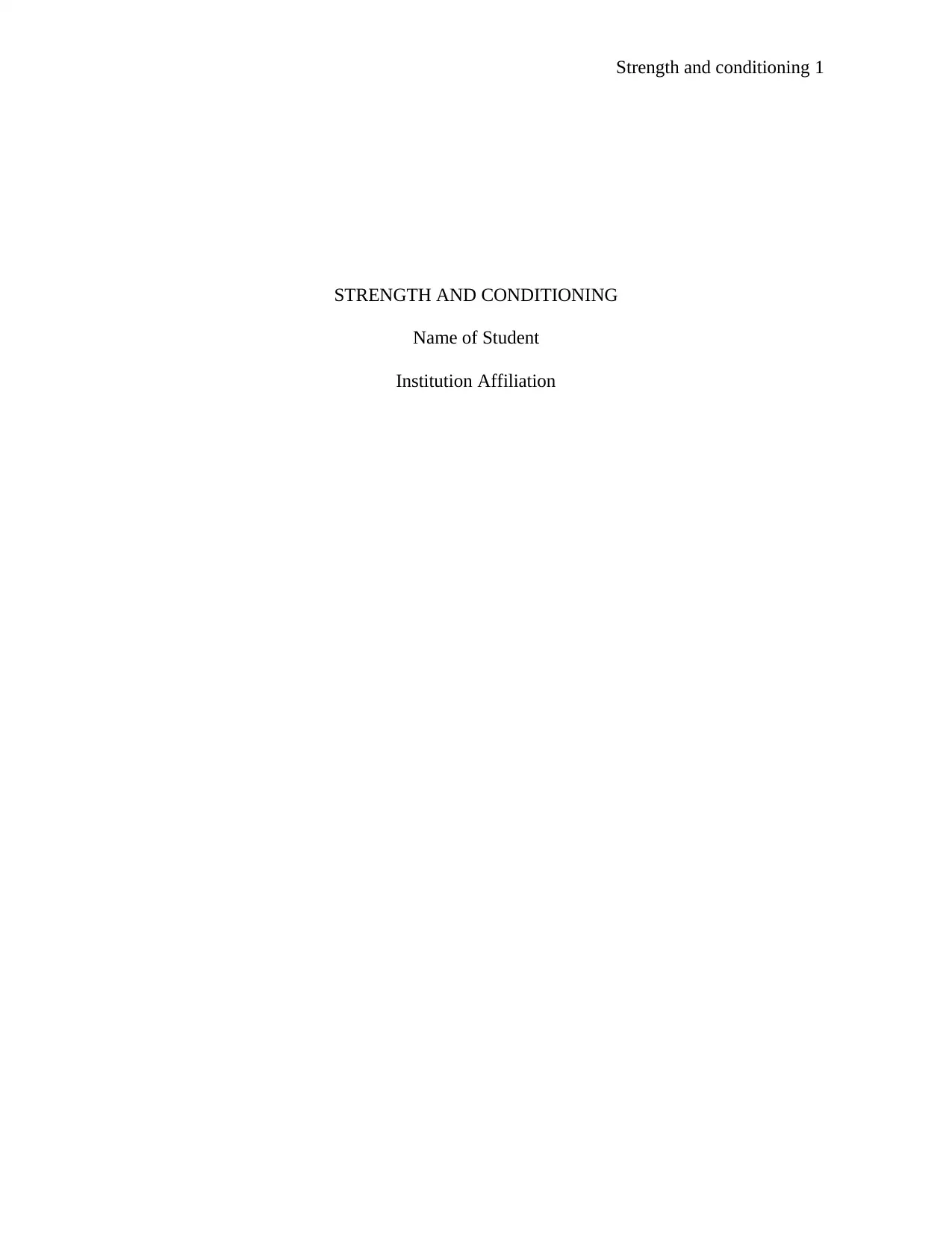
Strength and conditioning 1
STRENGTH AND CONDITIONING
Name of Student
Institution Affiliation
STRENGTH AND CONDITIONING
Name of Student
Institution Affiliation
Secure Best Marks with AI Grader
Need help grading? Try our AI Grader for instant feedback on your assignments.
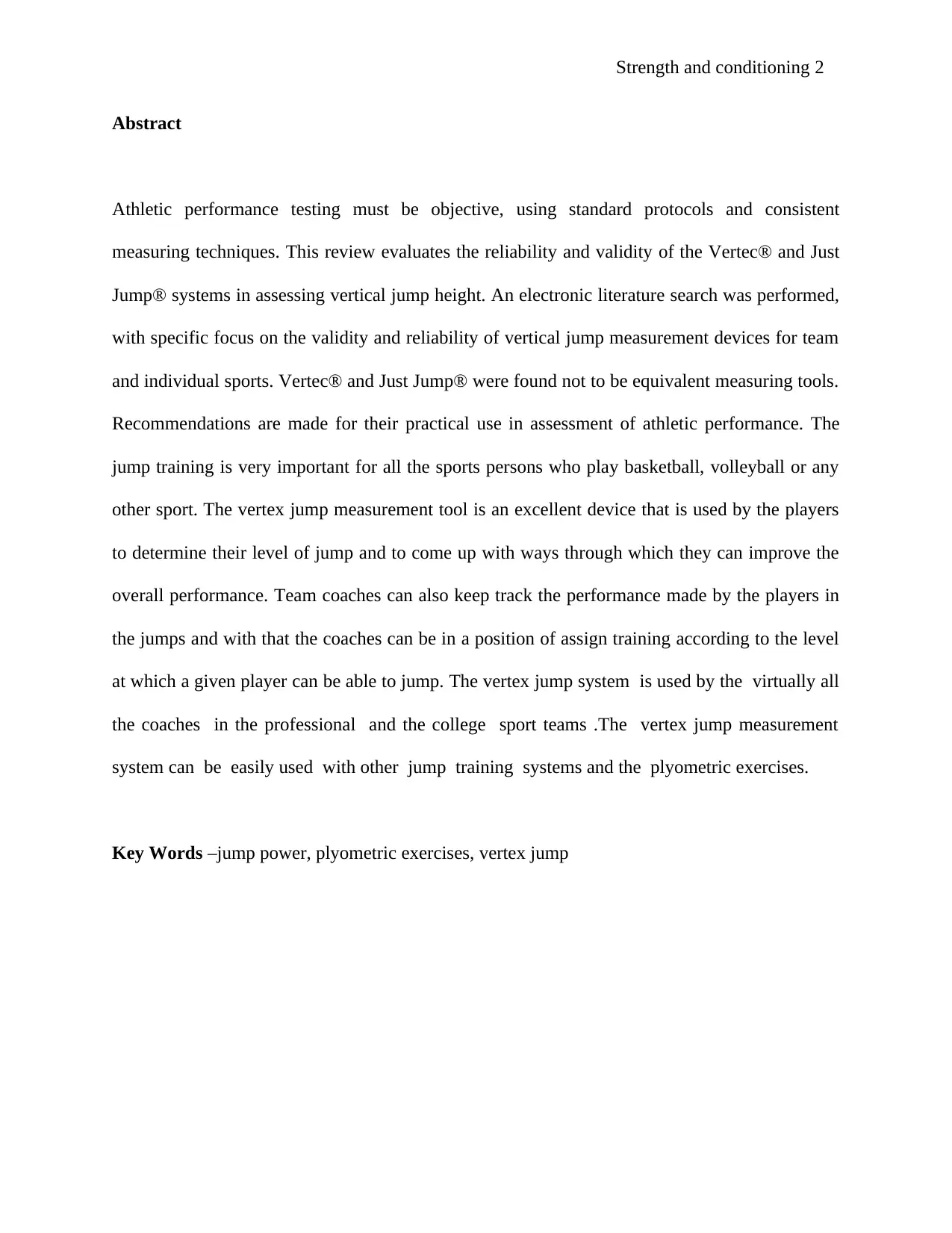
Strength and conditioning 2
Abstract
Athletic performance testing must be objective, using standard protocols and consistent
measuring techniques. This review evaluates the reliability and validity of the Vertec® and Just
Jump® systems in assessing vertical jump height. An electronic literature search was performed,
with specific focus on the validity and reliability of vertical jump measurement devices for team
and individual sports. Vertec® and Just Jump® were found not to be equivalent measuring tools.
Recommendations are made for their practical use in assessment of athletic performance. The
jump training is very important for all the sports persons who play basketball, volleyball or any
other sport. The vertex jump measurement tool is an excellent device that is used by the players
to determine their level of jump and to come up with ways through which they can improve the
overall performance. Team coaches can also keep track the performance made by the players in
the jumps and with that the coaches can be in a position of assign training according to the level
at which a given player can be able to jump. The vertex jump system is used by the virtually all
the coaches in the professional and the college sport teams .The vertex jump measurement
system can be easily used with other jump training systems and the plyometric exercises.
Key Words –jump power, plyometric exercises, vertex jump
Abstract
Athletic performance testing must be objective, using standard protocols and consistent
measuring techniques. This review evaluates the reliability and validity of the Vertec® and Just
Jump® systems in assessing vertical jump height. An electronic literature search was performed,
with specific focus on the validity and reliability of vertical jump measurement devices for team
and individual sports. Vertec® and Just Jump® were found not to be equivalent measuring tools.
Recommendations are made for their practical use in assessment of athletic performance. The
jump training is very important for all the sports persons who play basketball, volleyball or any
other sport. The vertex jump measurement tool is an excellent device that is used by the players
to determine their level of jump and to come up with ways through which they can improve the
overall performance. Team coaches can also keep track the performance made by the players in
the jumps and with that the coaches can be in a position of assign training according to the level
at which a given player can be able to jump. The vertex jump system is used by the virtually all
the coaches in the professional and the college sport teams .The vertex jump measurement
system can be easily used with other jump training systems and the plyometric exercises.
Key Words –jump power, plyometric exercises, vertex jump
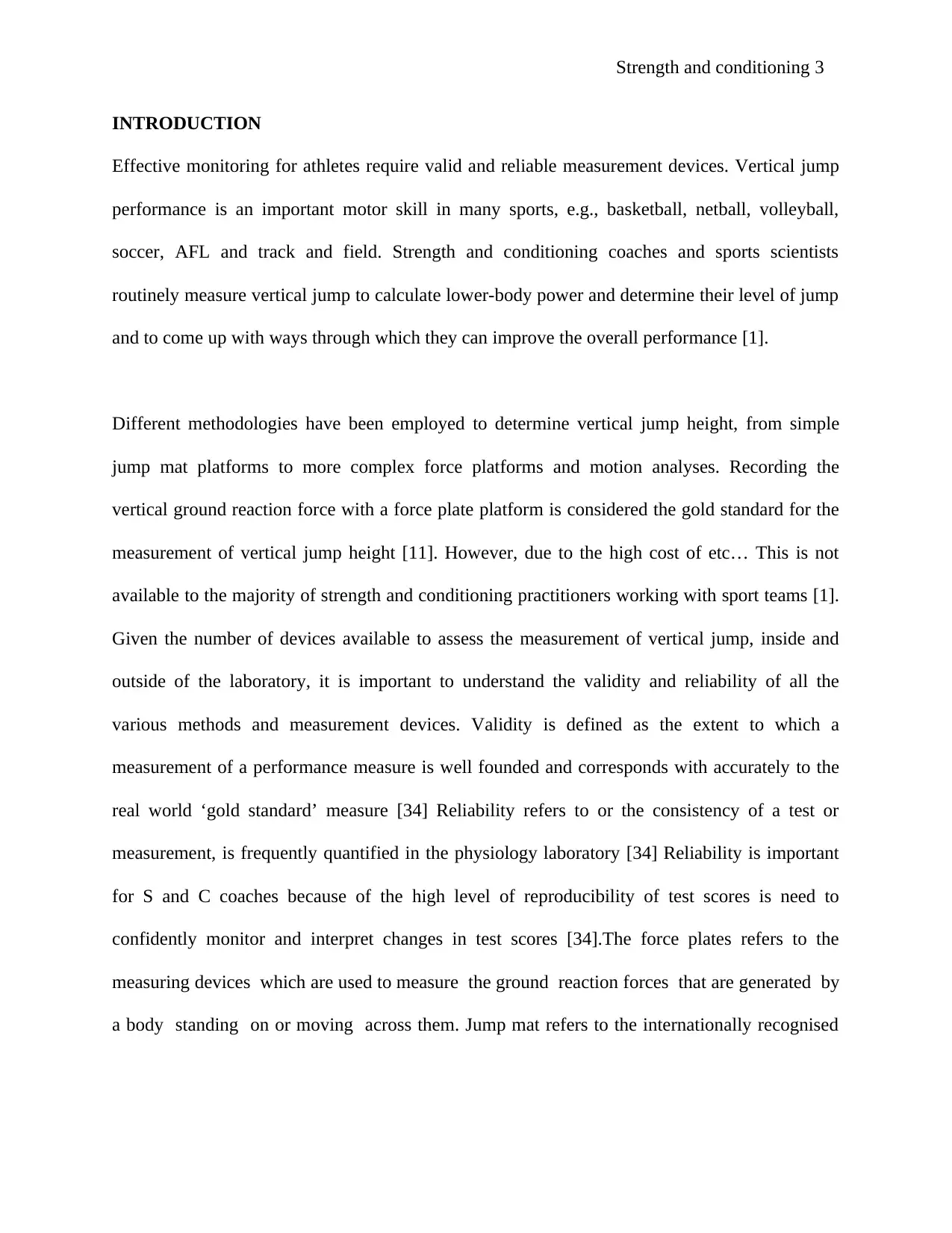
Strength and conditioning 3
INTRODUCTION
Effective monitoring for athletes require valid and reliable measurement devices. Vertical jump
performance is an important motor skill in many sports, e.g., basketball, netball, volleyball,
soccer, AFL and track and field. Strength and conditioning coaches and sports scientists
routinely measure vertical jump to calculate lower-body power and determine their level of jump
and to come up with ways through which they can improve the overall performance [1].
Different methodologies have been employed to determine vertical jump height, from simple
jump mat platforms to more complex force platforms and motion analyses. Recording the
vertical ground reaction force with a force plate platform is considered the gold standard for the
measurement of vertical jump height [11]. However, due to the high cost of etc… This is not
available to the majority of strength and conditioning practitioners working with sport teams [1].
Given the number of devices available to assess the measurement of vertical jump, inside and
outside of the laboratory, it is important to understand the validity and reliability of all the
various methods and measurement devices. Validity is defined as the extent to which a
measurement of a performance measure is well founded and corresponds with accurately to the
real world ‘gold standard’ measure [34] Reliability refers to or the consistency of a test or
measurement, is frequently quantified in the physiology laboratory [34] Reliability is important
for S and C coaches because of the high level of reproducibility of test scores is need to
confidently monitor and interpret changes in test scores [34].The force plates refers to the
measuring devices which are used to measure the ground reaction forces that are generated by
a body standing on or moving across them. Jump mat refers to the internationally recognised
INTRODUCTION
Effective monitoring for athletes require valid and reliable measurement devices. Vertical jump
performance is an important motor skill in many sports, e.g., basketball, netball, volleyball,
soccer, AFL and track and field. Strength and conditioning coaches and sports scientists
routinely measure vertical jump to calculate lower-body power and determine their level of jump
and to come up with ways through which they can improve the overall performance [1].
Different methodologies have been employed to determine vertical jump height, from simple
jump mat platforms to more complex force platforms and motion analyses. Recording the
vertical ground reaction force with a force plate platform is considered the gold standard for the
measurement of vertical jump height [11]. However, due to the high cost of etc… This is not
available to the majority of strength and conditioning practitioners working with sport teams [1].
Given the number of devices available to assess the measurement of vertical jump, inside and
outside of the laboratory, it is important to understand the validity and reliability of all the
various methods and measurement devices. Validity is defined as the extent to which a
measurement of a performance measure is well founded and corresponds with accurately to the
real world ‘gold standard’ measure [34] Reliability refers to or the consistency of a test or
measurement, is frequently quantified in the physiology laboratory [34] Reliability is important
for S and C coaches because of the high level of reproducibility of test scores is need to
confidently monitor and interpret changes in test scores [34].The force plates refers to the
measuring devices which are used to measure the ground reaction forces that are generated by
a body standing on or moving across them. Jump mat refers to the internationally recognised
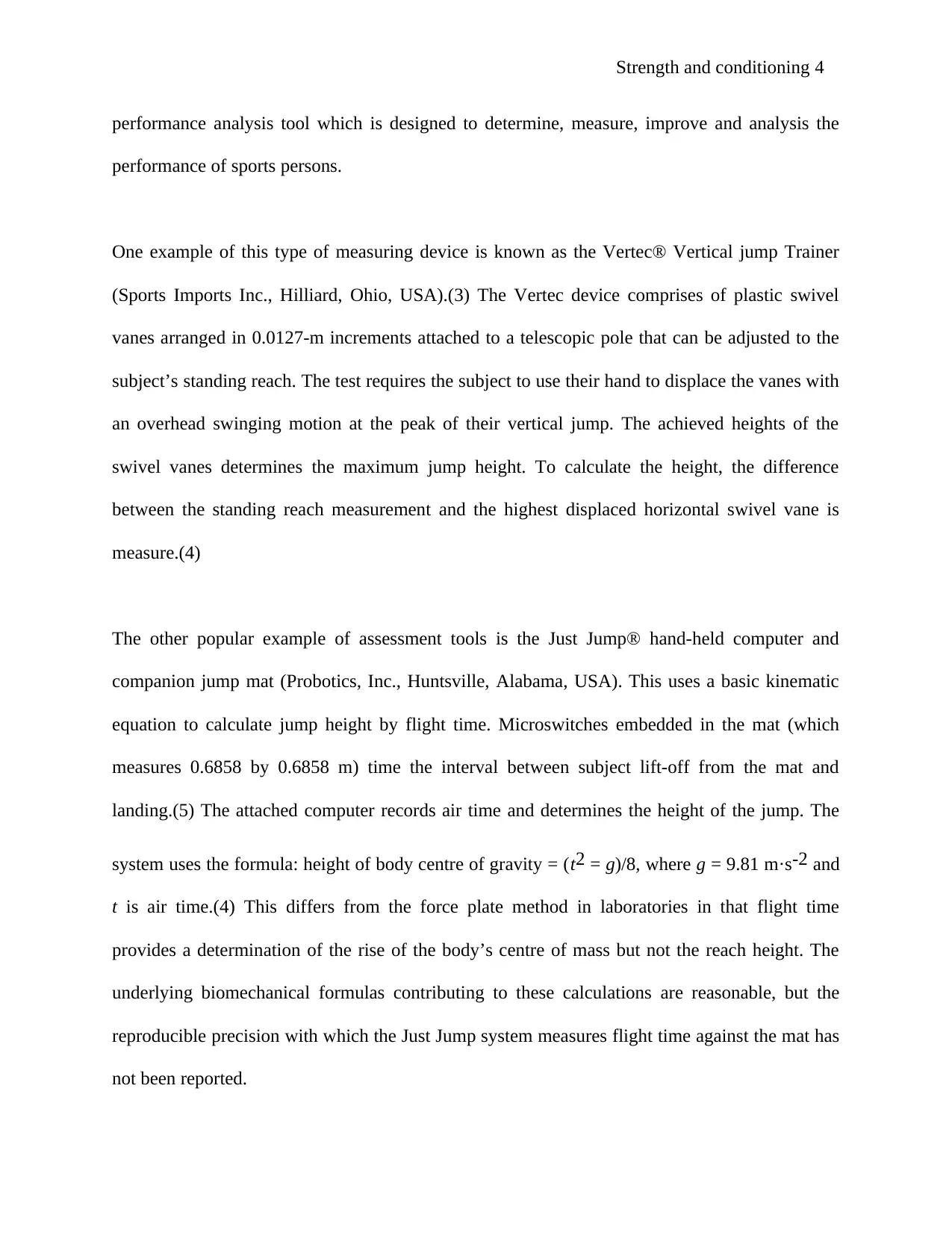
Strength and conditioning 4
performance analysis tool which is designed to determine, measure, improve and analysis the
performance of sports persons.
One example of this type of measuring device is known as the Vertec® Vertical jump Trainer
(Sports Imports Inc., Hilliard, Ohio, USA).(3) The Vertec device comprises of plastic swivel
vanes arranged in 0.0127-m increments attached to a telescopic pole that can be adjusted to the
subject’s standing reach. The test requires the subject to use their hand to displace the vanes with
an overhead swinging motion at the peak of their vertical jump. The achieved heights of the
swivel vanes determines the maximum jump height. To calculate the height, the difference
between the standing reach measurement and the highest displaced horizontal swivel vane is
measure.(4)
The other popular example of assessment tools is the Just Jump® hand-held computer and
companion jump mat (Probotics, Inc., Huntsville, Alabama, USA). This uses a basic kinematic
equation to calculate jump height by flight time. Microswitches embedded in the mat (which
measures 0.6858 by 0.6858 m) time the interval between subject lift-off from the mat and
landing.(5) The attached computer records air time and determines the height of the jump. The
system uses the formula: height of body centre of gravity = (t2 = g)/8, where g = 9.81 m·s-2 and
t is air time.(4) This differs from the force plate method in laboratories in that flight time
provides a determination of the rise of the body’s centre of mass but not the reach height. The
underlying biomechanical formulas contributing to these calculations are reasonable, but the
reproducible precision with which the Just Jump system measures flight time against the mat has
not been reported.
performance analysis tool which is designed to determine, measure, improve and analysis the
performance of sports persons.
One example of this type of measuring device is known as the Vertec® Vertical jump Trainer
(Sports Imports Inc., Hilliard, Ohio, USA).(3) The Vertec device comprises of plastic swivel
vanes arranged in 0.0127-m increments attached to a telescopic pole that can be adjusted to the
subject’s standing reach. The test requires the subject to use their hand to displace the vanes with
an overhead swinging motion at the peak of their vertical jump. The achieved heights of the
swivel vanes determines the maximum jump height. To calculate the height, the difference
between the standing reach measurement and the highest displaced horizontal swivel vane is
measure.(4)
The other popular example of assessment tools is the Just Jump® hand-held computer and
companion jump mat (Probotics, Inc., Huntsville, Alabama, USA). This uses a basic kinematic
equation to calculate jump height by flight time. Microswitches embedded in the mat (which
measures 0.6858 by 0.6858 m) time the interval between subject lift-off from the mat and
landing.(5) The attached computer records air time and determines the height of the jump. The
system uses the formula: height of body centre of gravity = (t2 = g)/8, where g = 9.81 m·s-2 and
t is air time.(4) This differs from the force plate method in laboratories in that flight time
provides a determination of the rise of the body’s centre of mass but not the reach height. The
underlying biomechanical formulas contributing to these calculations are reasonable, but the
reproducible precision with which the Just Jump system measures flight time against the mat has
not been reported.
Secure Best Marks with AI Grader
Need help grading? Try our AI Grader for instant feedback on your assignments.
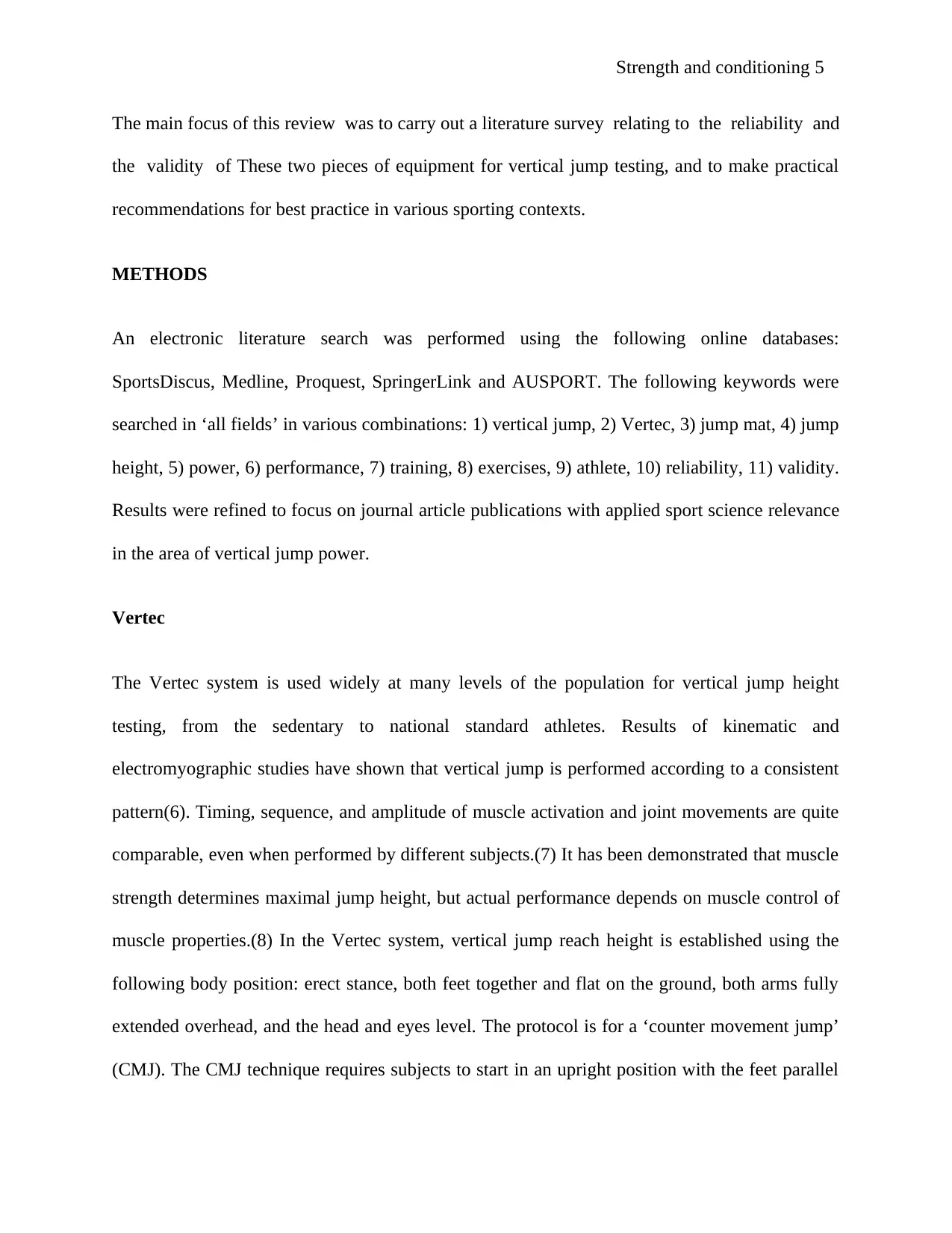
Strength and conditioning 5
The main focus of this review was to carry out a literature survey relating to the reliability and
the validity of These two pieces of equipment for vertical jump testing, and to make practical
recommendations for best practice in various sporting contexts.
METHODS
An electronic literature search was performed using the following online databases:
SportsDiscus, Medline, Proquest, SpringerLink and AUSPORT. The following keywords were
searched in ‘all fields’ in various combinations: 1) vertical jump, 2) Vertec, 3) jump mat, 4) jump
height, 5) power, 6) performance, 7) training, 8) exercises, 9) athlete, 10) reliability, 11) validity.
Results were refined to focus on journal article publications with applied sport science relevance
in the area of vertical jump power.
Vertec
The Vertec system is used widely at many levels of the population for vertical jump height
testing, from the sedentary to national standard athletes. Results of kinematic and
electromyographic studies have shown that vertical jump is performed according to a consistent
pattern(6). Timing, sequence, and amplitude of muscle activation and joint movements are quite
comparable, even when performed by different subjects.(7) It has been demonstrated that muscle
strength determines maximal jump height, but actual performance depends on muscle control of
muscle properties.(8) In the Vertec system, vertical jump reach height is established using the
following body position: erect stance, both feet together and flat on the ground, both arms fully
extended overhead, and the head and eyes level. The protocol is for a ‘counter movement jump’
(CMJ). The CMJ technique requires subjects to start in an upright position with the feet parallel
The main focus of this review was to carry out a literature survey relating to the reliability and
the validity of These two pieces of equipment for vertical jump testing, and to make practical
recommendations for best practice in various sporting contexts.
METHODS
An electronic literature search was performed using the following online databases:
SportsDiscus, Medline, Proquest, SpringerLink and AUSPORT. The following keywords were
searched in ‘all fields’ in various combinations: 1) vertical jump, 2) Vertec, 3) jump mat, 4) jump
height, 5) power, 6) performance, 7) training, 8) exercises, 9) athlete, 10) reliability, 11) validity.
Results were refined to focus on journal article publications with applied sport science relevance
in the area of vertical jump power.
Vertec
The Vertec system is used widely at many levels of the population for vertical jump height
testing, from the sedentary to national standard athletes. Results of kinematic and
electromyographic studies have shown that vertical jump is performed according to a consistent
pattern(6). Timing, sequence, and amplitude of muscle activation and joint movements are quite
comparable, even when performed by different subjects.(7) It has been demonstrated that muscle
strength determines maximal jump height, but actual performance depends on muscle control of
muscle properties.(8) In the Vertec system, vertical jump reach height is established using the
following body position: erect stance, both feet together and flat on the ground, both arms fully
extended overhead, and the head and eyes level. The protocol is for a ‘counter movement jump’
(CMJ). The CMJ technique requires subjects to start in an upright position with the feet parallel
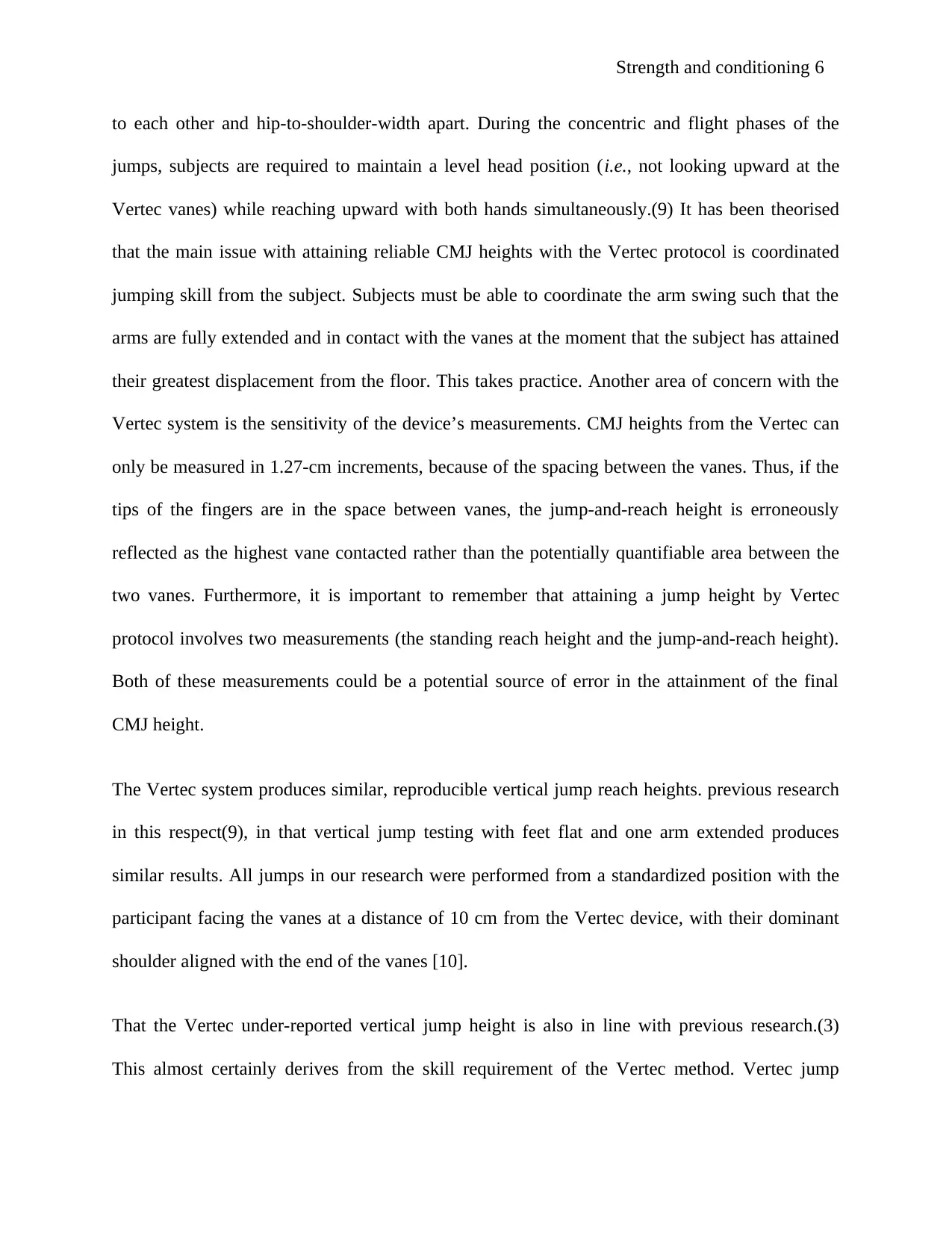
Strength and conditioning 6
to each other and hip-to-shoulder-width apart. During the concentric and flight phases of the
jumps, subjects are required to maintain a level head position (i.e., not looking upward at the
Vertec vanes) while reaching upward with both hands simultaneously.(9) It has been theorised
that the main issue with attaining reliable CMJ heights with the Vertec protocol is coordinated
jumping skill from the subject. Subjects must be able to coordinate the arm swing such that the
arms are fully extended and in contact with the vanes at the moment that the subject has attained
their greatest displacement from the floor. This takes practice. Another area of concern with the
Vertec system is the sensitivity of the device’s measurements. CMJ heights from the Vertec can
only be measured in 1.27-cm increments, because of the spacing between the vanes. Thus, if the
tips of the fingers are in the space between vanes, the jump-and-reach height is erroneously
reflected as the highest vane contacted rather than the potentially quantifiable area between the
two vanes. Furthermore, it is important to remember that attaining a jump height by Vertec
protocol involves two measurements (the standing reach height and the jump-and-reach height).
Both of these measurements could be a potential source of error in the attainment of the final
CMJ height.
The Vertec system produces similar, reproducible vertical jump reach heights. previous research
in this respect(9), in that vertical jump testing with feet flat and one arm extended produces
similar results. All jumps in our research were performed from a standardized position with the
participant facing the vanes at a distance of 10 cm from the Vertec device, with their dominant
shoulder aligned with the end of the vanes [10].
That the Vertec under-reported vertical jump height is also in line with previous research.(3)
This almost certainly derives from the skill requirement of the Vertec method. Vertec jump
to each other and hip-to-shoulder-width apart. During the concentric and flight phases of the
jumps, subjects are required to maintain a level head position (i.e., not looking upward at the
Vertec vanes) while reaching upward with both hands simultaneously.(9) It has been theorised
that the main issue with attaining reliable CMJ heights with the Vertec protocol is coordinated
jumping skill from the subject. Subjects must be able to coordinate the arm swing such that the
arms are fully extended and in contact with the vanes at the moment that the subject has attained
their greatest displacement from the floor. This takes practice. Another area of concern with the
Vertec system is the sensitivity of the device’s measurements. CMJ heights from the Vertec can
only be measured in 1.27-cm increments, because of the spacing between the vanes. Thus, if the
tips of the fingers are in the space between vanes, the jump-and-reach height is erroneously
reflected as the highest vane contacted rather than the potentially quantifiable area between the
two vanes. Furthermore, it is important to remember that attaining a jump height by Vertec
protocol involves two measurements (the standing reach height and the jump-and-reach height).
Both of these measurements could be a potential source of error in the attainment of the final
CMJ height.
The Vertec system produces similar, reproducible vertical jump reach heights. previous research
in this respect(9), in that vertical jump testing with feet flat and one arm extended produces
similar results. All jumps in our research were performed from a standardized position with the
participant facing the vanes at a distance of 10 cm from the Vertec device, with their dominant
shoulder aligned with the end of the vanes [10].
That the Vertec under-reported vertical jump height is also in line with previous research.(3)
This almost certainly derives from the skill requirement of the Vertec method. Vertec jump
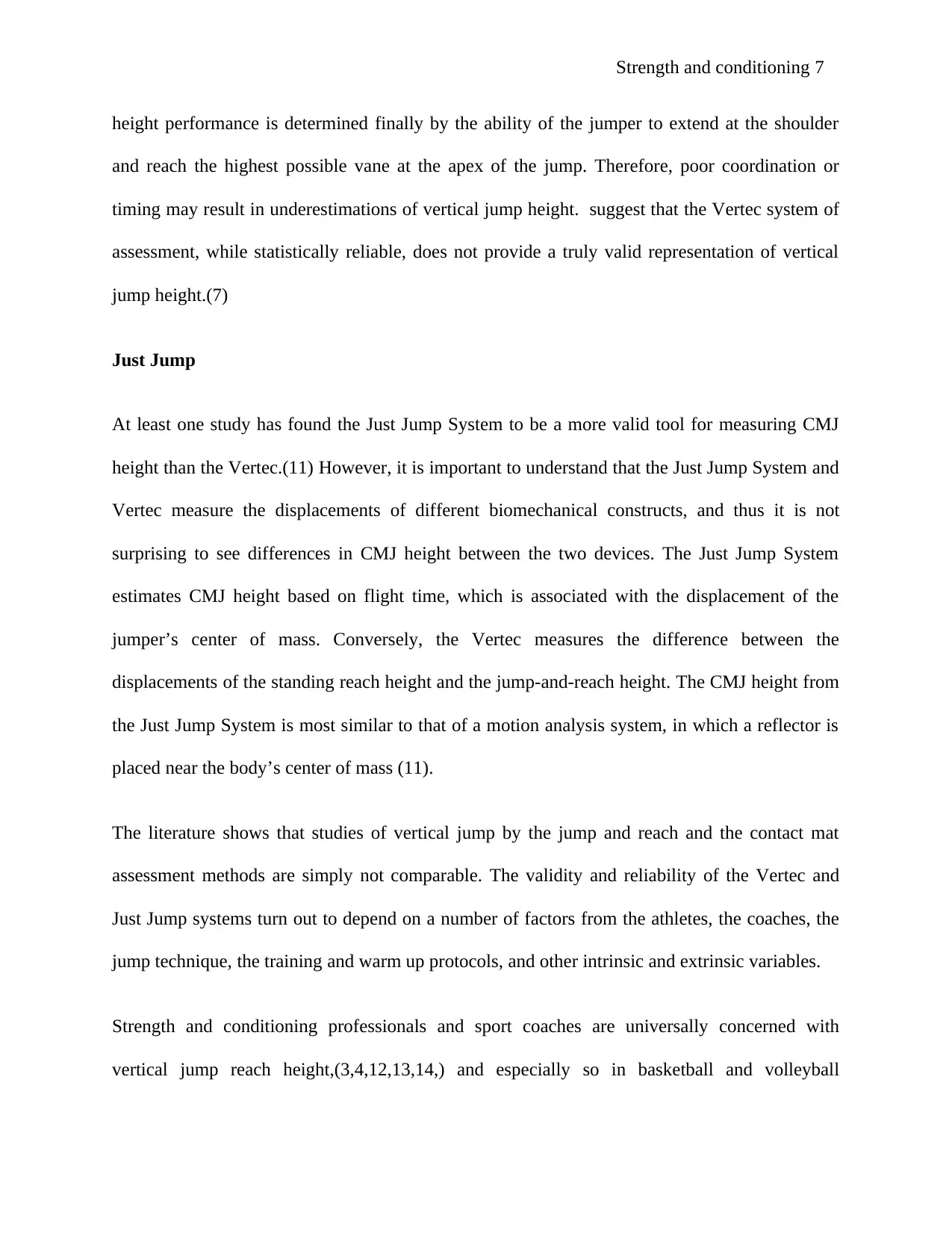
Strength and conditioning 7
height performance is determined finally by the ability of the jumper to extend at the shoulder
and reach the highest possible vane at the apex of the jump. Therefore, poor coordination or
timing may result in underestimations of vertical jump height. suggest that the Vertec system of
assessment, while statistically reliable, does not provide a truly valid representation of vertical
jump height.(7)
Just Jump
At least one study has found the Just Jump System to be a more valid tool for measuring CMJ
height than the Vertec.(11) However, it is important to understand that the Just Jump System and
Vertec measure the displacements of different biomechanical constructs, and thus it is not
surprising to see differences in CMJ height between the two devices. The Just Jump System
estimates CMJ height based on flight time, which is associated with the displacement of the
jumper’s center of mass. Conversely, the Vertec measures the difference between the
displacements of the standing reach height and the jump-and-reach height. The CMJ height from
the Just Jump System is most similar to that of a motion analysis system, in which a reflector is
placed near the body’s center of mass (11).
The literature shows that studies of vertical jump by the jump and reach and the contact mat
assessment methods are simply not comparable. The validity and reliability of the Vertec and
Just Jump systems turn out to depend on a number of factors from the athletes, the coaches, the
jump technique, the training and warm up protocols, and other intrinsic and extrinsic variables.
Strength and conditioning professionals and sport coaches are universally concerned with
vertical jump reach height,(3,4,12,13,14,) and especially so in basketball and volleyball
height performance is determined finally by the ability of the jumper to extend at the shoulder
and reach the highest possible vane at the apex of the jump. Therefore, poor coordination or
timing may result in underestimations of vertical jump height. suggest that the Vertec system of
assessment, while statistically reliable, does not provide a truly valid representation of vertical
jump height.(7)
Just Jump
At least one study has found the Just Jump System to be a more valid tool for measuring CMJ
height than the Vertec.(11) However, it is important to understand that the Just Jump System and
Vertec measure the displacements of different biomechanical constructs, and thus it is not
surprising to see differences in CMJ height between the two devices. The Just Jump System
estimates CMJ height based on flight time, which is associated with the displacement of the
jumper’s center of mass. Conversely, the Vertec measures the difference between the
displacements of the standing reach height and the jump-and-reach height. The CMJ height from
the Just Jump System is most similar to that of a motion analysis system, in which a reflector is
placed near the body’s center of mass (11).
The literature shows that studies of vertical jump by the jump and reach and the contact mat
assessment methods are simply not comparable. The validity and reliability of the Vertec and
Just Jump systems turn out to depend on a number of factors from the athletes, the coaches, the
jump technique, the training and warm up protocols, and other intrinsic and extrinsic variables.
Strength and conditioning professionals and sport coaches are universally concerned with
vertical jump reach height,(3,4,12,13,14,) and especially so in basketball and volleyball
Paraphrase This Document
Need a fresh take? Get an instant paraphrase of this document with our AI Paraphraser
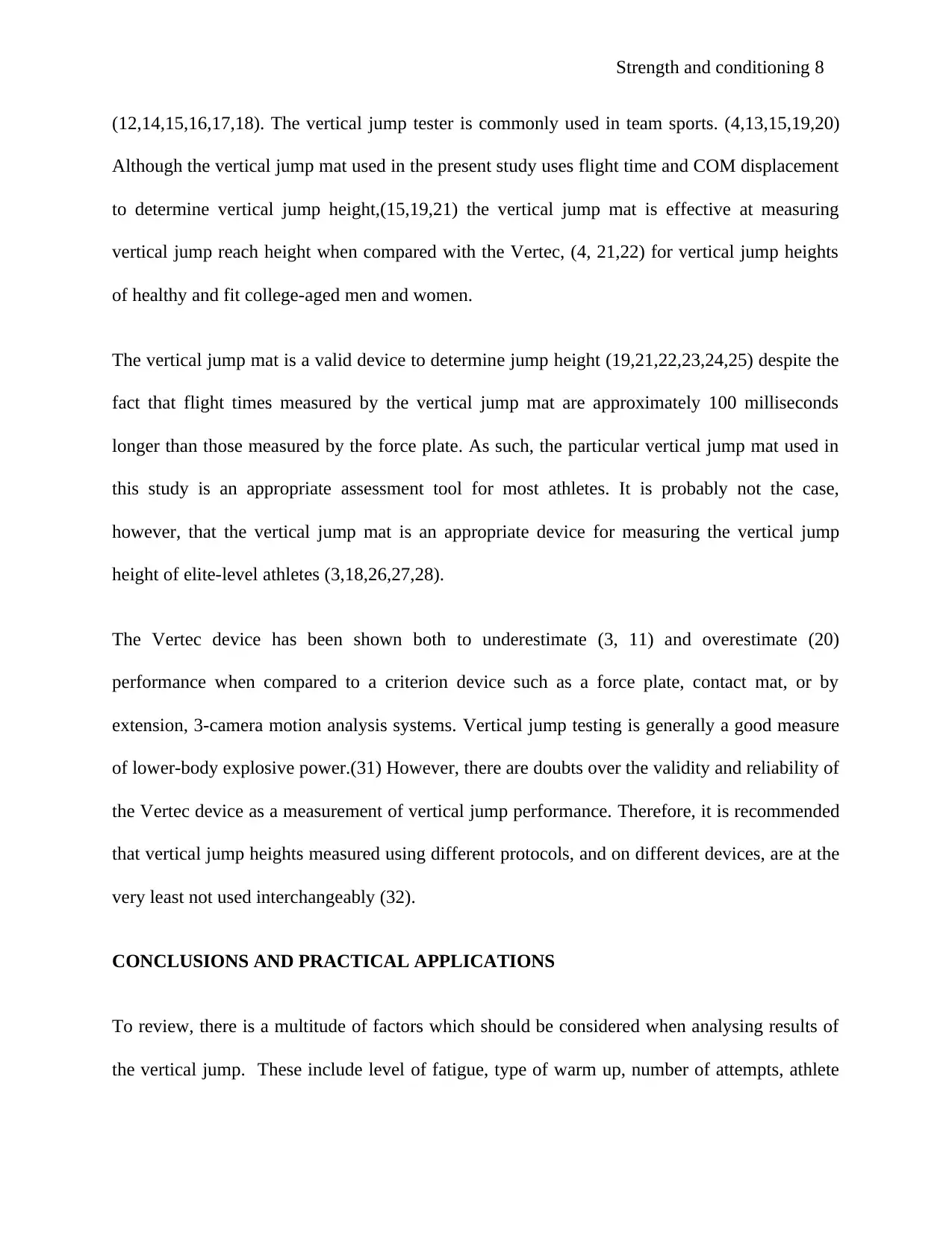
Strength and conditioning 8
(12,14,15,16,17,18). The vertical jump tester is commonly used in team sports. (4,13,15,19,20)
Although the vertical jump mat used in the present study uses flight time and COM displacement
to determine vertical jump height,(15,19,21) the vertical jump mat is effective at measuring
vertical jump reach height when compared with the Vertec, (4, 21,22) for vertical jump heights
of healthy and fit college-aged men and women.
The vertical jump mat is a valid device to determine jump height (19,21,22,23,24,25) despite the
fact that flight times measured by the vertical jump mat are approximately 100 milliseconds
longer than those measured by the force plate. As such, the particular vertical jump mat used in
this study is an appropriate assessment tool for most athletes. It is probably not the case,
however, that the vertical jump mat is an appropriate device for measuring the vertical jump
height of elite-level athletes (3,18,26,27,28).
The Vertec device has been shown both to underestimate (3, 11) and overestimate (20)
performance when compared to a criterion device such as a force plate, contact mat, or by
extension, 3-camera motion analysis systems. Vertical jump testing is generally a good measure
of lower-body explosive power.(31) However, there are doubts over the validity and reliability of
the Vertec device as a measurement of vertical jump performance. Therefore, it is recommended
that vertical jump heights measured using different protocols, and on different devices, are at the
very least not used interchangeably (32).
CONCLUSIONS AND PRACTICAL APPLICATIONS
To review, there is a multitude of factors which should be considered when analysing results of
the vertical jump. These include level of fatigue, type of warm up, number of attempts, athlete
(12,14,15,16,17,18). The vertical jump tester is commonly used in team sports. (4,13,15,19,20)
Although the vertical jump mat used in the present study uses flight time and COM displacement
to determine vertical jump height,(15,19,21) the vertical jump mat is effective at measuring
vertical jump reach height when compared with the Vertec, (4, 21,22) for vertical jump heights
of healthy and fit college-aged men and women.
The vertical jump mat is a valid device to determine jump height (19,21,22,23,24,25) despite the
fact that flight times measured by the vertical jump mat are approximately 100 milliseconds
longer than those measured by the force plate. As such, the particular vertical jump mat used in
this study is an appropriate assessment tool for most athletes. It is probably not the case,
however, that the vertical jump mat is an appropriate device for measuring the vertical jump
height of elite-level athletes (3,18,26,27,28).
The Vertec device has been shown both to underestimate (3, 11) and overestimate (20)
performance when compared to a criterion device such as a force plate, contact mat, or by
extension, 3-camera motion analysis systems. Vertical jump testing is generally a good measure
of lower-body explosive power.(31) However, there are doubts over the validity and reliability of
the Vertec device as a measurement of vertical jump performance. Therefore, it is recommended
that vertical jump heights measured using different protocols, and on different devices, are at the
very least not used interchangeably (32).
CONCLUSIONS AND PRACTICAL APPLICATIONS
To review, there is a multitude of factors which should be considered when analysing results of
the vertical jump. These include level of fatigue, type of warm up, number of attempts, athlete
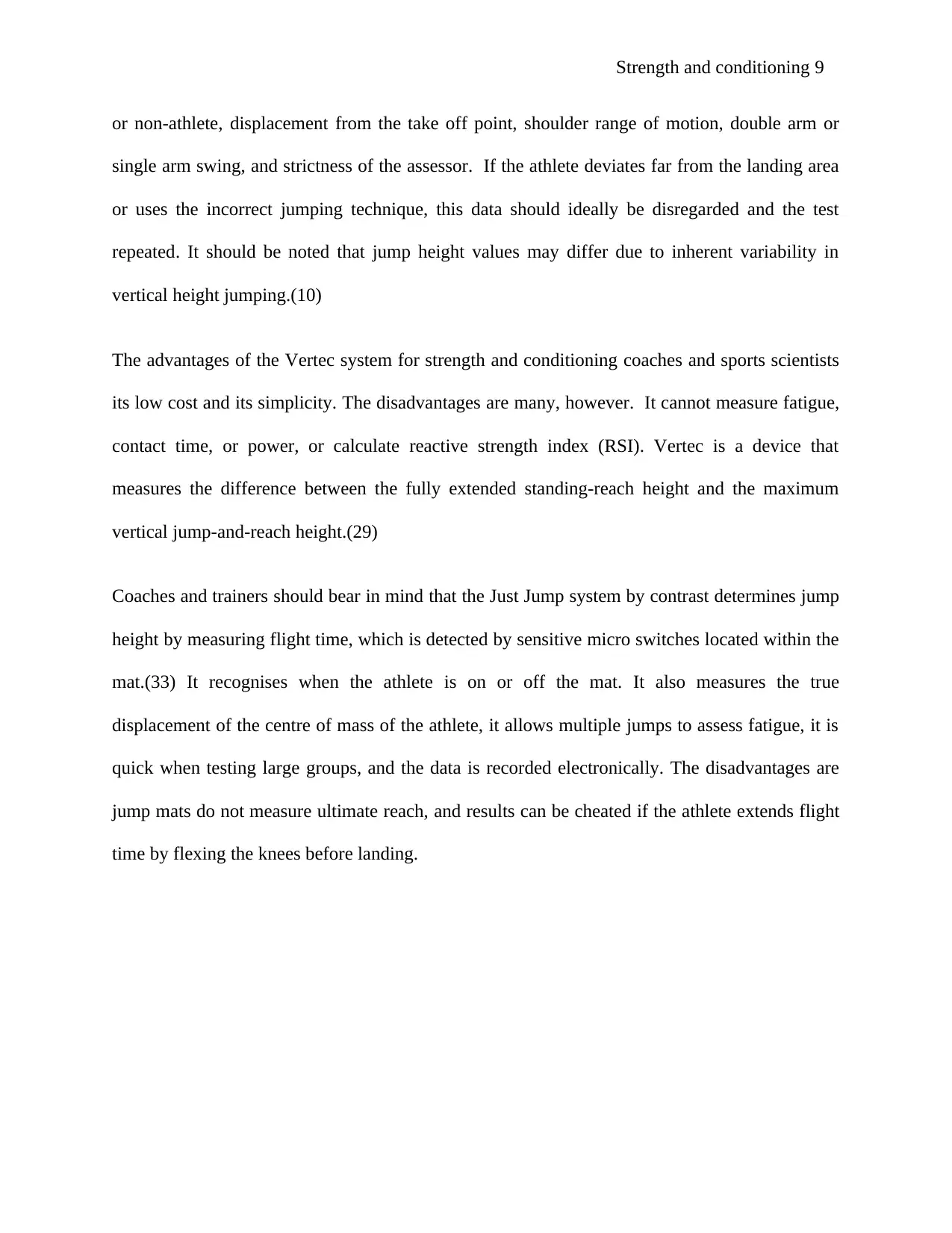
Strength and conditioning 9
or non-athlete, displacement from the take off point, shoulder range of motion, double arm or
single arm swing, and strictness of the assessor. If the athlete deviates far from the landing area
or uses the incorrect jumping technique, this data should ideally be disregarded and the test
repeated. It should be noted that jump height values may differ due to inherent variability in
vertical height jumping.(10)
The advantages of the Vertec system for strength and conditioning coaches and sports scientists
its low cost and its simplicity. The disadvantages are many, however. It cannot measure fatigue,
contact time, or power, or calculate reactive strength index (RSI). Vertec is a device that
measures the difference between the fully extended standing-reach height and the maximum
vertical jump-and-reach height.(29)
Coaches and trainers should bear in mind that the Just Jump system by contrast determines jump
height by measuring flight time, which is detected by sensitive micro switches located within the
mat.(33) It recognises when the athlete is on or off the mat. It also measures the true
displacement of the centre of mass of the athlete, it allows multiple jumps to assess fatigue, it is
quick when testing large groups, and the data is recorded electronically. The disadvantages are
jump mats do not measure ultimate reach, and results can be cheated if the athlete extends flight
time by flexing the knees before landing.
or non-athlete, displacement from the take off point, shoulder range of motion, double arm or
single arm swing, and strictness of the assessor. If the athlete deviates far from the landing area
or uses the incorrect jumping technique, this data should ideally be disregarded and the test
repeated. It should be noted that jump height values may differ due to inherent variability in
vertical height jumping.(10)
The advantages of the Vertec system for strength and conditioning coaches and sports scientists
its low cost and its simplicity. The disadvantages are many, however. It cannot measure fatigue,
contact time, or power, or calculate reactive strength index (RSI). Vertec is a device that
measures the difference between the fully extended standing-reach height and the maximum
vertical jump-and-reach height.(29)
Coaches and trainers should bear in mind that the Just Jump system by contrast determines jump
height by measuring flight time, which is detected by sensitive micro switches located within the
mat.(33) It recognises when the athlete is on or off the mat. It also measures the true
displacement of the centre of mass of the athlete, it allows multiple jumps to assess fatigue, it is
quick when testing large groups, and the data is recorded electronically. The disadvantages are
jump mats do not measure ultimate reach, and results can be cheated if the athlete extends flight
time by flexing the knees before landing.
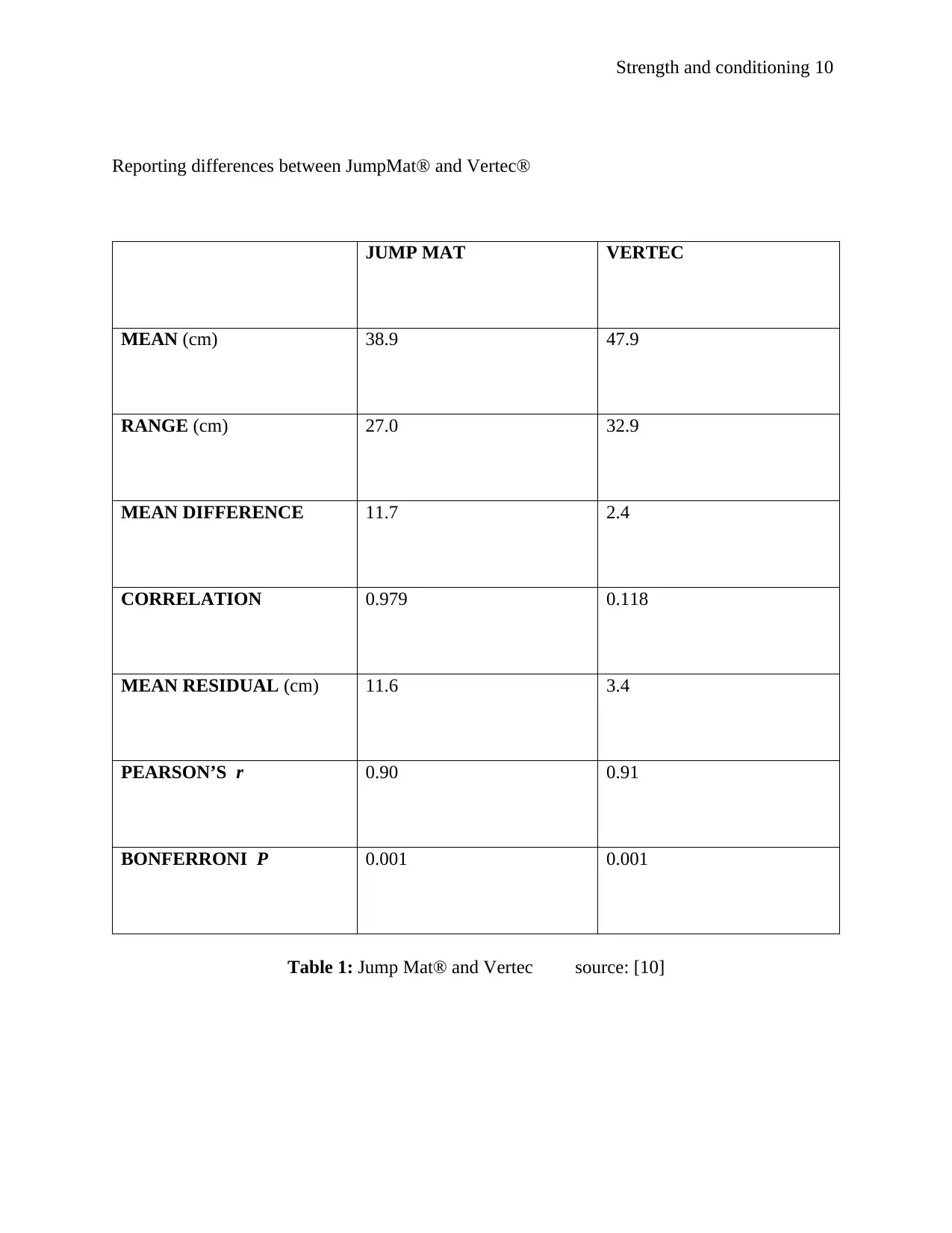
Strength and conditioning 10
Reporting differences between JumpMat® and Vertec®
JUMP MAT VERTEC
MEAN (cm) 38.9 47.9
RANGE (cm) 27.0 32.9
MEAN DIFFERENCE 11.7 2.4
CORRELATION 0.979 0.118
MEAN RESIDUAL (cm) 11.6 3.4
PEARSON’S r 0.90 0.91
BONFERRONI P 0.001 0.001
Table 1: Jump Mat® and Vertec source: [10]
Reporting differences between JumpMat® and Vertec®
JUMP MAT VERTEC
MEAN (cm) 38.9 47.9
RANGE (cm) 27.0 32.9
MEAN DIFFERENCE 11.7 2.4
CORRELATION 0.979 0.118
MEAN RESIDUAL (cm) 11.6 3.4
PEARSON’S r 0.90 0.91
BONFERRONI P 0.001 0.001
Table 1: Jump Mat® and Vertec source: [10]
Secure Best Marks with AI Grader
Need help grading? Try our AI Grader for instant feedback on your assignments.
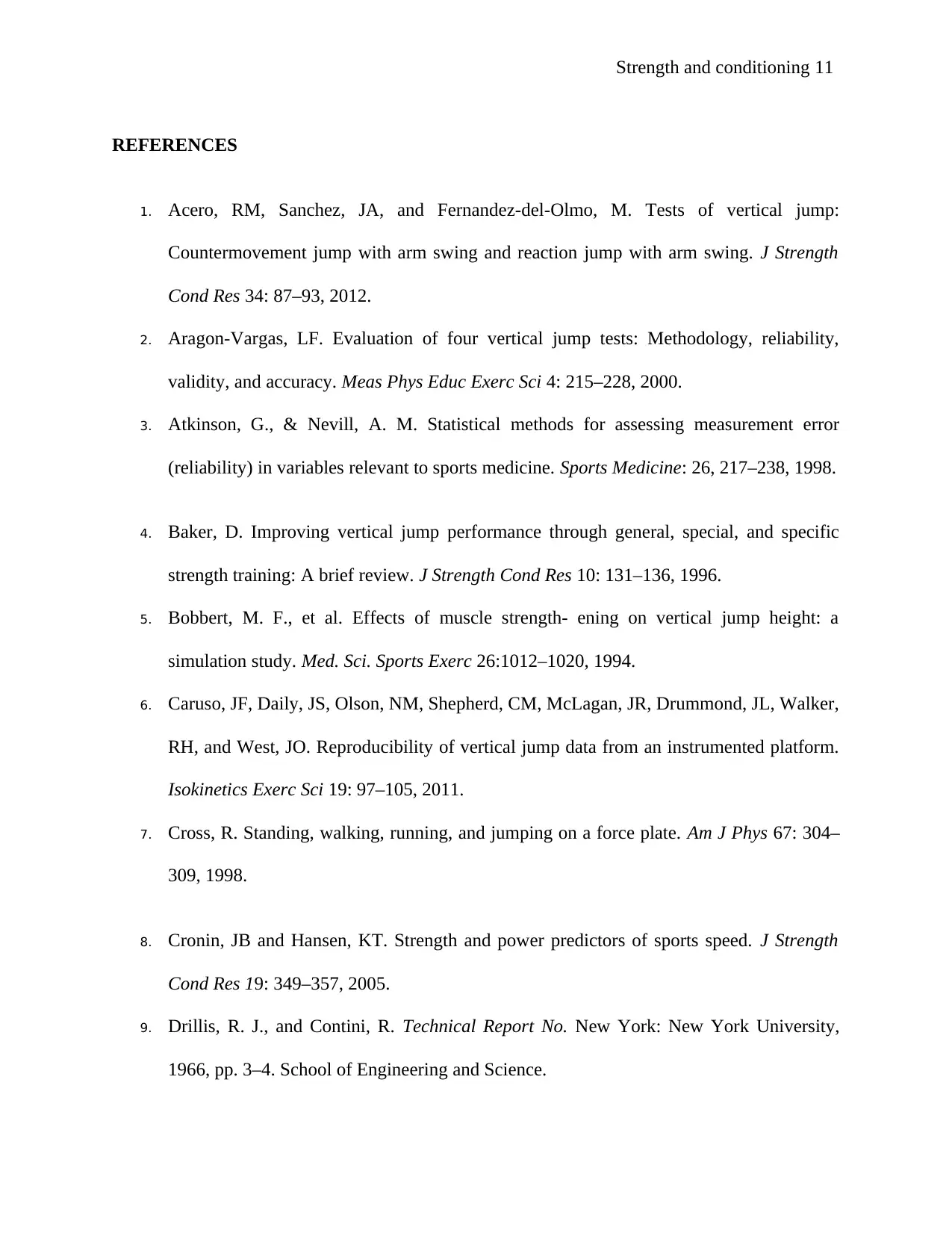
Strength and conditioning 11
REFERENCES
1. Acero, RM, Sanchez, JA, and Fernandez-del-Olmo, M. Tests of vertical jump:
Countermovement jump with arm swing and reaction jump with arm swing. J Strength
Cond Res 34: 87–93, 2012.
2. Aragon-Vargas, LF. Evaluation of four vertical jump tests: Methodology, reliability,
validity, and accuracy. Meas Phys Educ Exerc Sci 4: 215–228, 2000.
3. Atkinson, G., & Nevill, A. M. Statistical methods for assessing measurement error
(reliability) in variables relevant to sports medicine. Sports Medicine: 26, 217–238, 1998.
4. Baker, D. Improving vertical jump performance through general, special, and specific
strength training: A brief review. J Strength Cond Res 10: 131–136, 1996.
5. Bobbert, M. F., et al. Effects of muscle strength- ening on vertical jump height: a
simulation study. Med. Sci. Sports Exerc 26:1012–1020, 1994.
6. Caruso, JF, Daily, JS, Olson, NM, Shepherd, CM, McLagan, JR, Drummond, JL, Walker,
RH, and West, JO. Reproducibility of vertical jump data from an instrumented platform.
Isokinetics Exerc Sci 19: 97–105, 2011.
7. Cross, R. Standing, walking, running, and jumping on a force plate. Am J Phys 67: 304–
309, 1998.
8. Cronin, JB and Hansen, KT. Strength and power predictors of sports speed. J Strength
Cond Res 19: 349–357, 2005.
9. Drillis, R. J., and Contini, R. Technical Report No. New York: New York University,
1966, pp. 3–4. School of Engineering and Science.
REFERENCES
1. Acero, RM, Sanchez, JA, and Fernandez-del-Olmo, M. Tests of vertical jump:
Countermovement jump with arm swing and reaction jump with arm swing. J Strength
Cond Res 34: 87–93, 2012.
2. Aragon-Vargas, LF. Evaluation of four vertical jump tests: Methodology, reliability,
validity, and accuracy. Meas Phys Educ Exerc Sci 4: 215–228, 2000.
3. Atkinson, G., & Nevill, A. M. Statistical methods for assessing measurement error
(reliability) in variables relevant to sports medicine. Sports Medicine: 26, 217–238, 1998.
4. Baker, D. Improving vertical jump performance through general, special, and specific
strength training: A brief review. J Strength Cond Res 10: 131–136, 1996.
5. Bobbert, M. F., et al. Effects of muscle strength- ening on vertical jump height: a
simulation study. Med. Sci. Sports Exerc 26:1012–1020, 1994.
6. Caruso, JF, Daily, JS, Olson, NM, Shepherd, CM, McLagan, JR, Drummond, JL, Walker,
RH, and West, JO. Reproducibility of vertical jump data from an instrumented platform.
Isokinetics Exerc Sci 19: 97–105, 2011.
7. Cross, R. Standing, walking, running, and jumping on a force plate. Am J Phys 67: 304–
309, 1998.
8. Cronin, JB and Hansen, KT. Strength and power predictors of sports speed. J Strength
Cond Res 19: 349–357, 2005.
9. Drillis, R. J., and Contini, R. Technical Report No. New York: New York University,
1966, pp. 3–4. School of Engineering and Science.
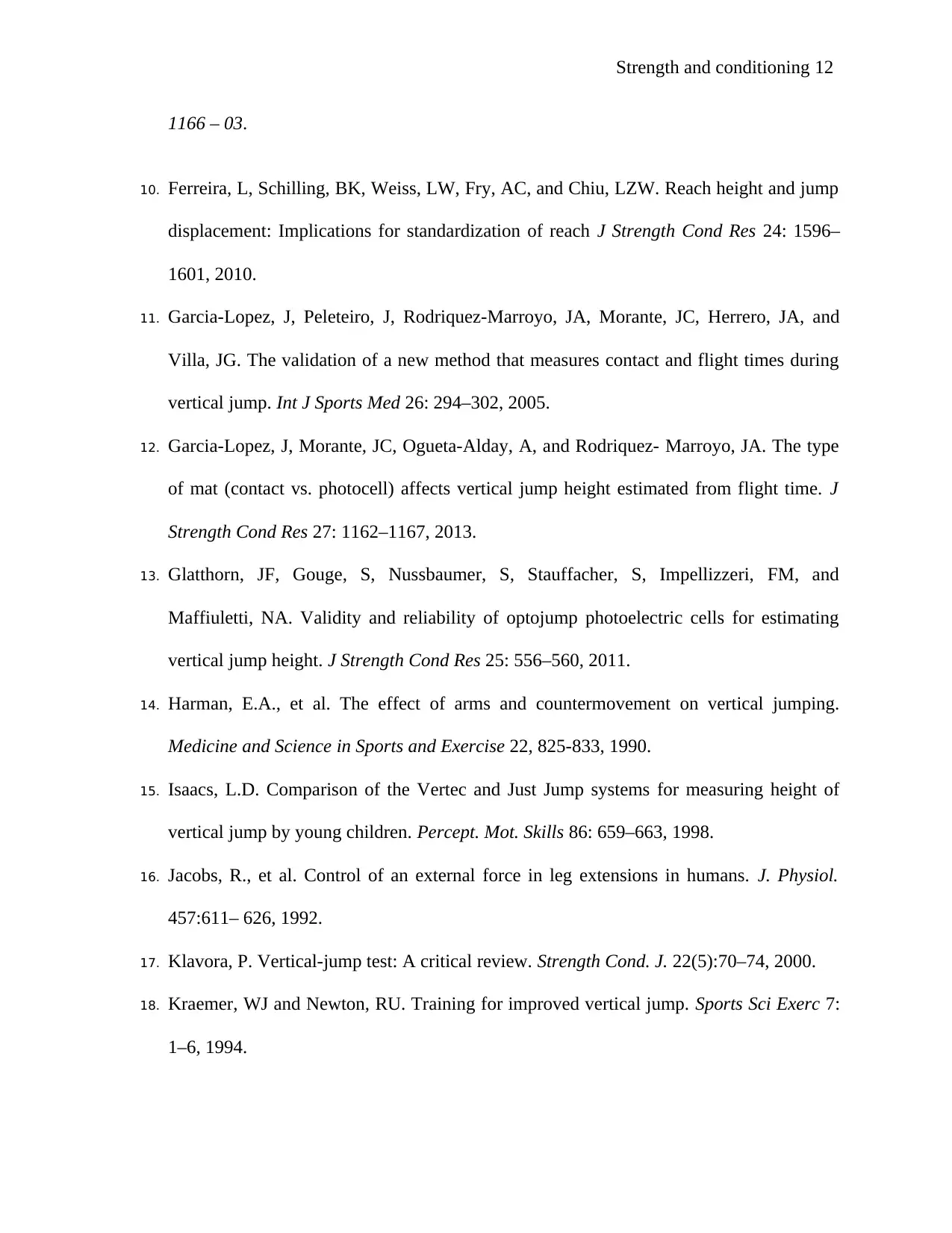
Strength and conditioning 12
1166 – 03.
10. Ferreira, L, Schilling, BK, Weiss, LW, Fry, AC, and Chiu, LZW. Reach height and jump
displacement: Implications for standardization of reach J Strength Cond Res 24: 1596–
1601, 2010.
11. Garcia-Lopez, J, Peleteiro, J, Rodriquez-Marroyo, JA, Morante, JC, Herrero, JA, and
Villa, JG. The validation of a new method that measures contact and flight times during
vertical jump. Int J Sports Med 26: 294–302, 2005.
12. Garcia-Lopez, J, Morante, JC, Ogueta-Alday, A, and Rodriquez- Marroyo, JA. The type
of mat (contact vs. photocell) affects vertical jump height estimated from flight time. J
Strength Cond Res 27: 1162–1167, 2013.
13. Glatthorn, JF, Gouge, S, Nussbaumer, S, Stauffacher, S, Impellizzeri, FM, and
Maffiuletti, NA. Validity and reliability of optojump photoelectric cells for estimating
vertical jump height. J Strength Cond Res 25: 556–560, 2011.
14. Harman, E.A., et al. The effect of arms and countermovement on vertical jumping.
Medicine and Science in Sports and Exercise 22, 825-833, 1990.
15. Isaacs, L.D. Comparison of the Vertec and Just Jump systems for measuring height of
vertical jump by young children. Percept. Mot. Skills 86: 659–663, 1998.
16. Jacobs, R., et al. Control of an external force in leg extensions in humans. J. Physiol.
457:611– 626, 1992.
17. Klavora, P. Vertical-jump test: A critical review. Strength Cond. J. 22(5):70–74, 2000.
18. Kraemer, WJ and Newton, RU. Training for improved vertical jump. Sports Sci Exerc 7:
1–6, 1994.
1166 – 03.
10. Ferreira, L, Schilling, BK, Weiss, LW, Fry, AC, and Chiu, LZW. Reach height and jump
displacement: Implications for standardization of reach J Strength Cond Res 24: 1596–
1601, 2010.
11. Garcia-Lopez, J, Peleteiro, J, Rodriquez-Marroyo, JA, Morante, JC, Herrero, JA, and
Villa, JG. The validation of a new method that measures contact and flight times during
vertical jump. Int J Sports Med 26: 294–302, 2005.
12. Garcia-Lopez, J, Morante, JC, Ogueta-Alday, A, and Rodriquez- Marroyo, JA. The type
of mat (contact vs. photocell) affects vertical jump height estimated from flight time. J
Strength Cond Res 27: 1162–1167, 2013.
13. Glatthorn, JF, Gouge, S, Nussbaumer, S, Stauffacher, S, Impellizzeri, FM, and
Maffiuletti, NA. Validity and reliability of optojump photoelectric cells for estimating
vertical jump height. J Strength Cond Res 25: 556–560, 2011.
14. Harman, E.A., et al. The effect of arms and countermovement on vertical jumping.
Medicine and Science in Sports and Exercise 22, 825-833, 1990.
15. Isaacs, L.D. Comparison of the Vertec and Just Jump systems for measuring height of
vertical jump by young children. Percept. Mot. Skills 86: 659–663, 1998.
16. Jacobs, R., et al. Control of an external force in leg extensions in humans. J. Physiol.
457:611– 626, 1992.
17. Klavora, P. Vertical-jump test: A critical review. Strength Cond. J. 22(5):70–74, 2000.
18. Kraemer, WJ and Newton, RU. Training for improved vertical jump. Sports Sci Exerc 7:
1–6, 1994.
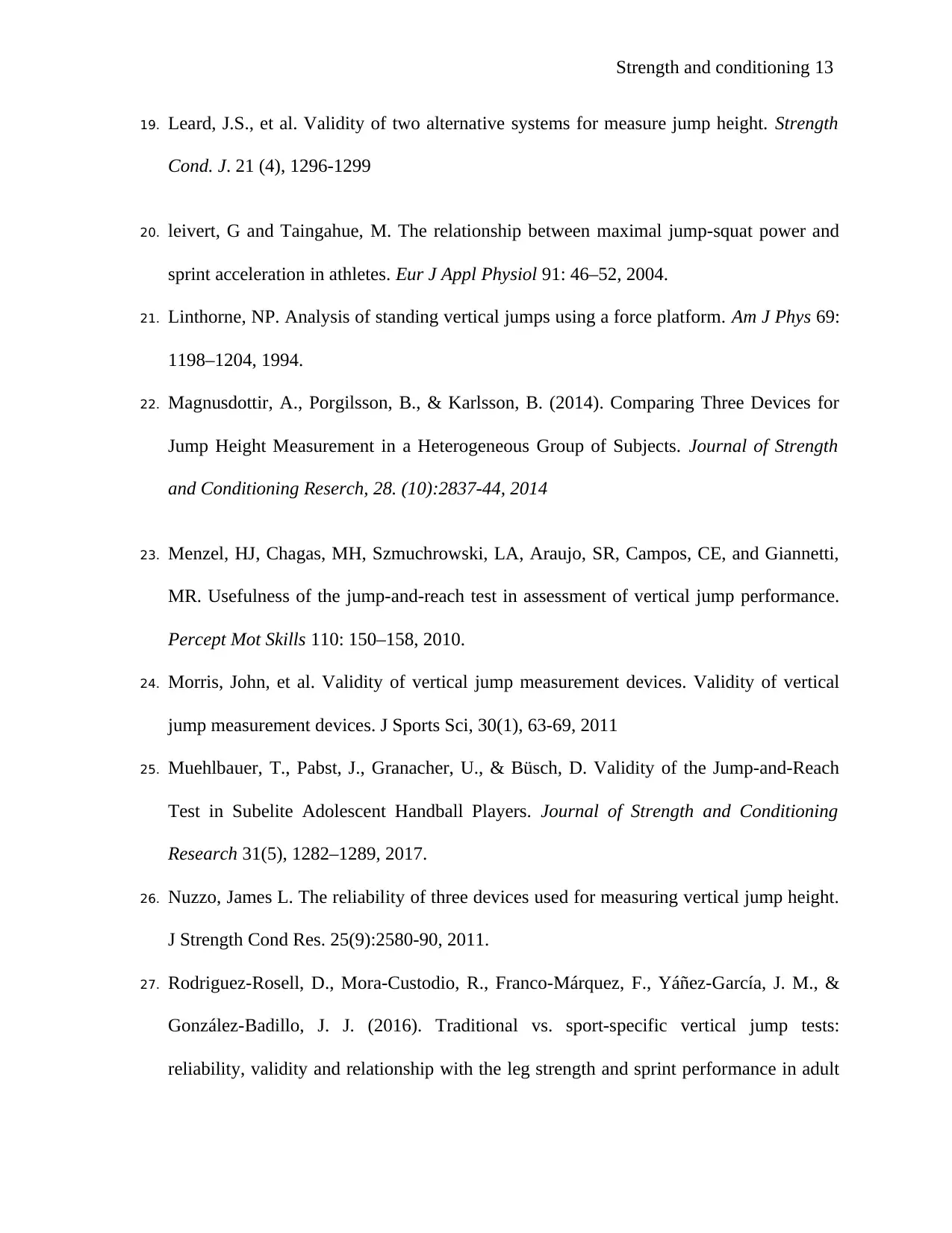
Strength and conditioning 13
19. Leard, J.S., et al. Validity of two alternative systems for measure jump height. Strength
Cond. J. 21 (4), 1296-1299
20. leivert, G and Taingahue, M. The relationship between maximal jump-squat power and
sprint acceleration in athletes. Eur J Appl Physiol 91: 46–52, 2004.
21. Linthorne, NP. Analysis of standing vertical jumps using a force platform. Am J Phys 69:
1198–1204, 1994.
22. Magnusdottir, A., Porgilsson, B., & Karlsson, B. (2014). Comparing Three Devices for
Jump Height Measurement in a Heterogeneous Group of Subjects. Journal of Strength
and Conditioning Reserch, 28. (10):2837-44, 2014
23. Menzel, HJ, Chagas, MH, Szmuchrowski, LA, Araujo, SR, Campos, CE, and Giannetti,
MR. Usefulness of the jump-and-reach test in assessment of vertical jump performance.
Percept Mot Skills 110: 150–158, 2010.
24. Morris, John, et al. Validity of vertical jump measurement devices. Validity of vertical
jump measurement devices. J Sports Sci, 30(1), 63-69, 2011
25. Muehlbauer, T., Pabst, J., Granacher, U., & Büsch, D. Validity of the Jump-and-Reach
Test in Subelite Adolescent Handball Players. Journal of Strength and Conditioning
Research 31(5), 1282–1289, 2017.
26. Nuzzo, James L. The reliability of three devices used for measuring vertical jump height.
J Strength Cond Res. 25(9):2580-90, 2011.
27. Rodriguez-Rosell, D., Mora-Custodio, R., Franco-Márquez, F., Yáñez-García, J. M., &
González-Badillo, J. J. (2016). Traditional vs. sport-specific vertical jump tests:
reliability, validity and relationship with the leg strength and sprint performance in adult
19. Leard, J.S., et al. Validity of two alternative systems for measure jump height. Strength
Cond. J. 21 (4), 1296-1299
20. leivert, G and Taingahue, M. The relationship between maximal jump-squat power and
sprint acceleration in athletes. Eur J Appl Physiol 91: 46–52, 2004.
21. Linthorne, NP. Analysis of standing vertical jumps using a force platform. Am J Phys 69:
1198–1204, 1994.
22. Magnusdottir, A., Porgilsson, B., & Karlsson, B. (2014). Comparing Three Devices for
Jump Height Measurement in a Heterogeneous Group of Subjects. Journal of Strength
and Conditioning Reserch, 28. (10):2837-44, 2014
23. Menzel, HJ, Chagas, MH, Szmuchrowski, LA, Araujo, SR, Campos, CE, and Giannetti,
MR. Usefulness of the jump-and-reach test in assessment of vertical jump performance.
Percept Mot Skills 110: 150–158, 2010.
24. Morris, John, et al. Validity of vertical jump measurement devices. Validity of vertical
jump measurement devices. J Sports Sci, 30(1), 63-69, 2011
25. Muehlbauer, T., Pabst, J., Granacher, U., & Büsch, D. Validity of the Jump-and-Reach
Test in Subelite Adolescent Handball Players. Journal of Strength and Conditioning
Research 31(5), 1282–1289, 2017.
26. Nuzzo, James L. The reliability of three devices used for measuring vertical jump height.
J Strength Cond Res. 25(9):2580-90, 2011.
27. Rodriguez-Rosell, D., Mora-Custodio, R., Franco-Márquez, F., Yáñez-García, J. M., &
González-Badillo, J. J. (2016). Traditional vs. sport-specific vertical jump tests:
reliability, validity and relationship with the leg strength and sprint performance in adult
Paraphrase This Document
Need a fresh take? Get an instant paraphrase of this document with our AI Paraphraser
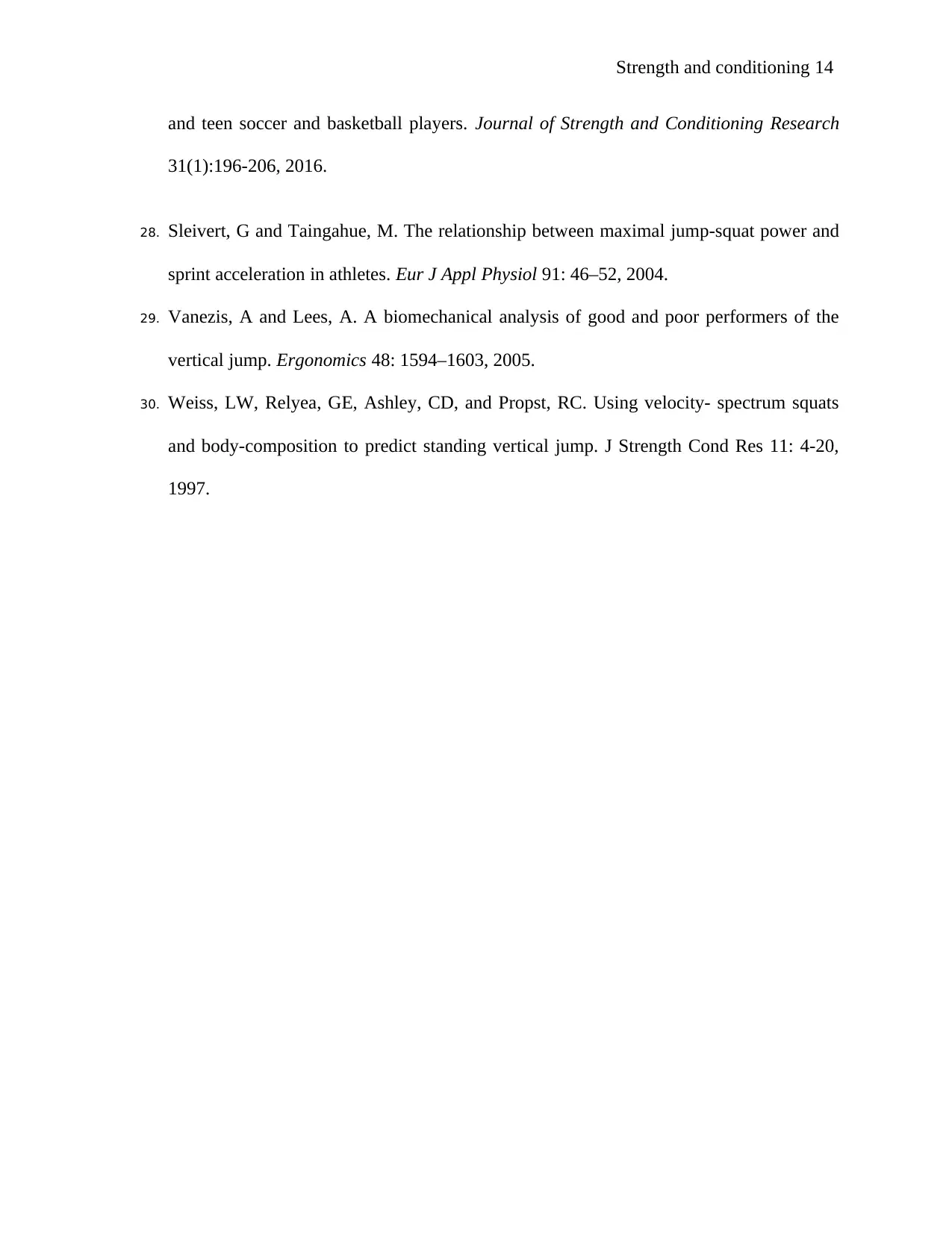
Strength and conditioning 14
and teen soccer and basketball players. Journal of Strength and Conditioning Research
31(1):196-206, 2016.
28. Sleivert, G and Taingahue, M. The relationship between maximal jump-squat power and
sprint acceleration in athletes. Eur J Appl Physiol 91: 46–52, 2004.
29. Vanezis, A and Lees, A. A biomechanical analysis of good and poor performers of the
vertical jump. Ergonomics 48: 1594–1603, 2005.
30. Weiss, LW, Relyea, GE, Ashley, CD, and Propst, RC. Using velocity- spectrum squats
and body-composition to predict standing vertical jump. J Strength Cond Res 11: 4-20,
1997.
and teen soccer and basketball players. Journal of Strength and Conditioning Research
31(1):196-206, 2016.
28. Sleivert, G and Taingahue, M. The relationship between maximal jump-squat power and
sprint acceleration in athletes. Eur J Appl Physiol 91: 46–52, 2004.
29. Vanezis, A and Lees, A. A biomechanical analysis of good and poor performers of the
vertical jump. Ergonomics 48: 1594–1603, 2005.
30. Weiss, LW, Relyea, GE, Ashley, CD, and Propst, RC. Using velocity- spectrum squats
and body-composition to predict standing vertical jump. J Strength Cond Res 11: 4-20,
1997.
1 out of 14
Your All-in-One AI-Powered Toolkit for Academic Success.
+13062052269
info@desklib.com
Available 24*7 on WhatsApp / Email
![[object Object]](/_next/static/media/star-bottom.7253800d.svg)
Unlock your academic potential
© 2024 | Zucol Services PVT LTD | All rights reserved.
